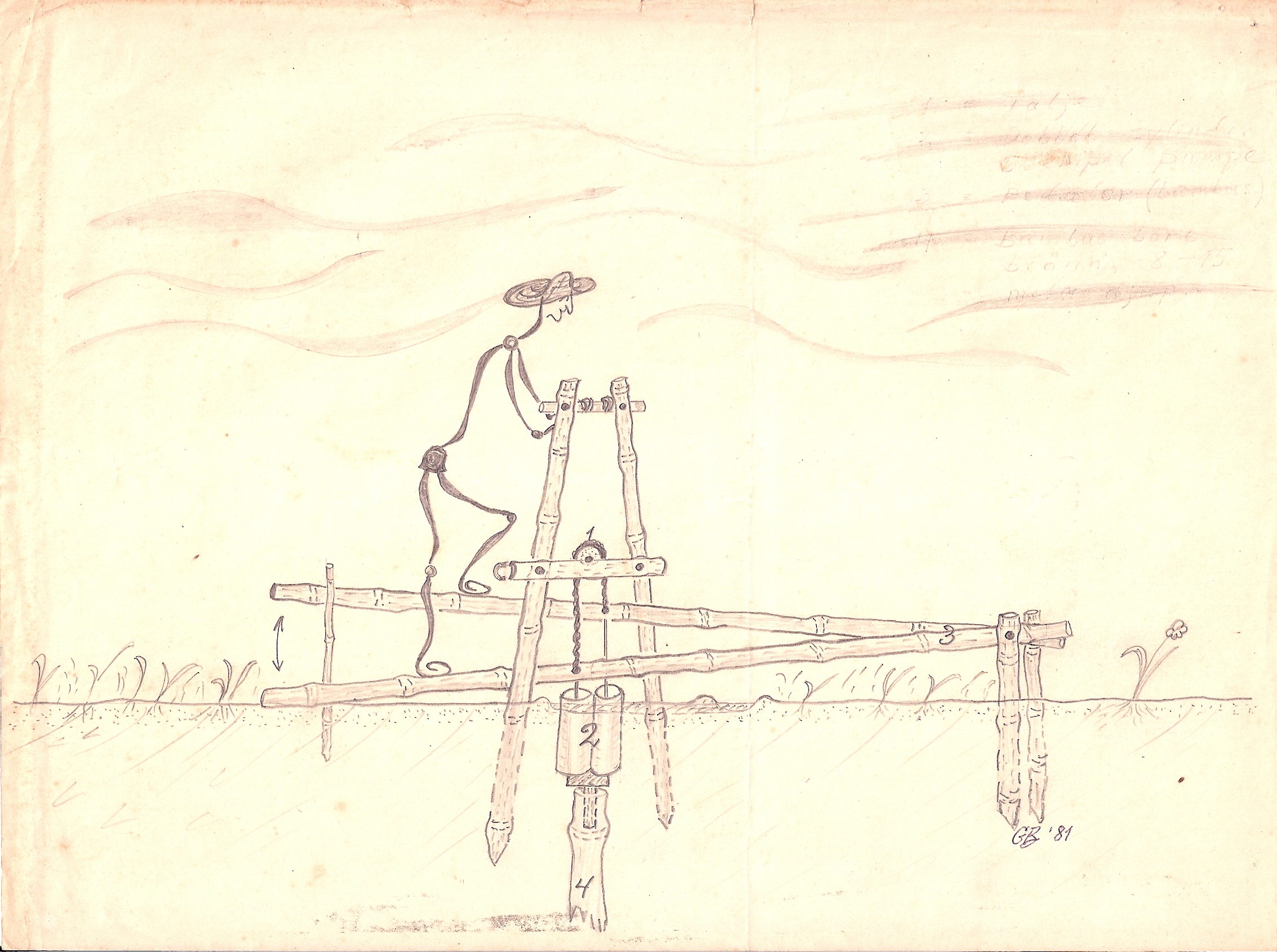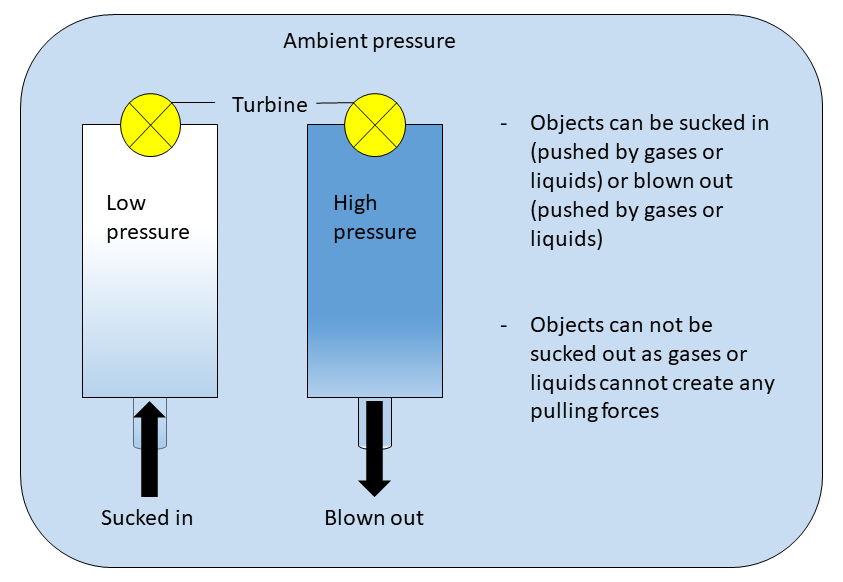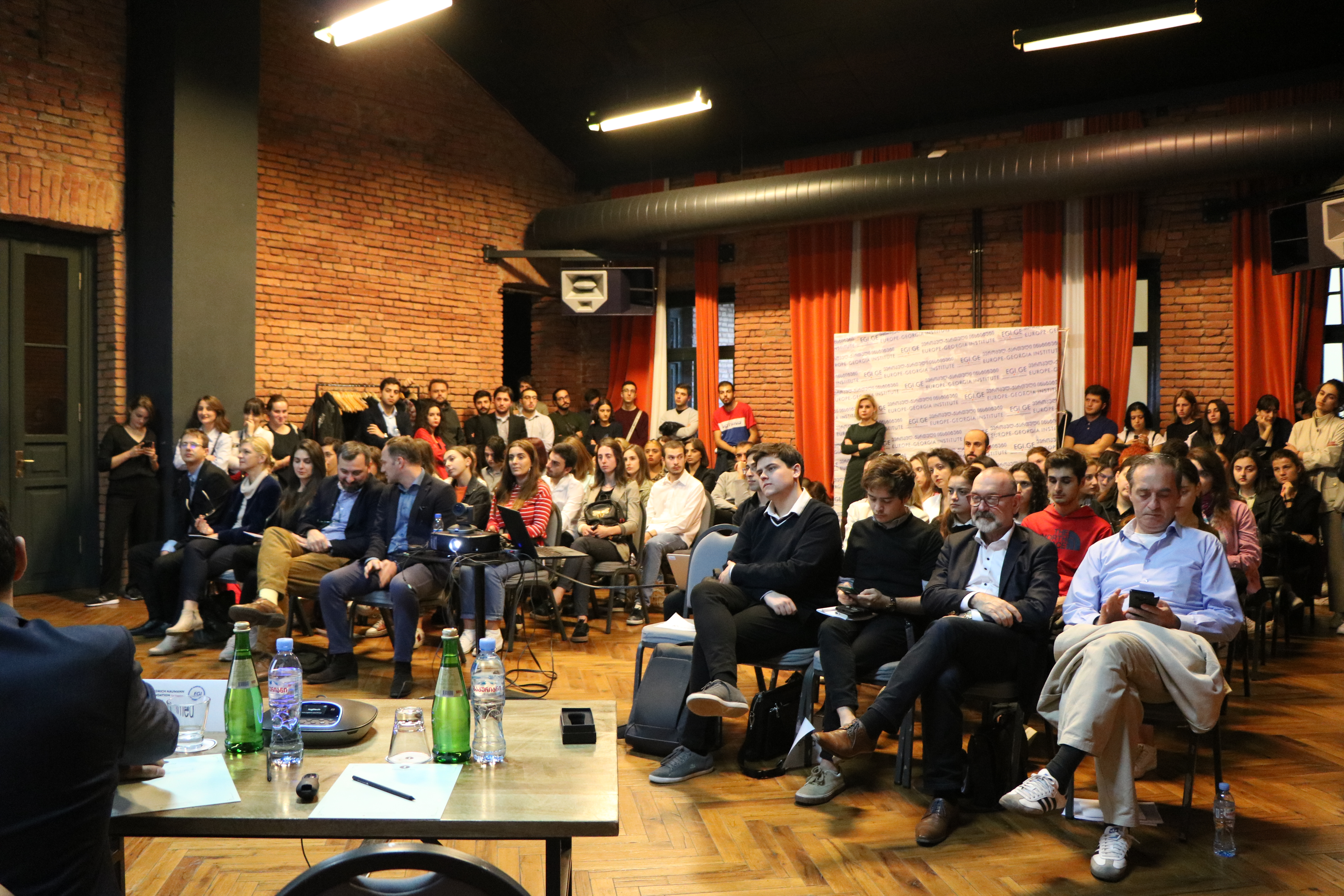|
Treadle Pump
A treadle pump is a human-powered suction pump that sits on top of a well and is used for irrigation. It is designed to lift water from a depth of seven metres or less. The pumping is activated by stepping up and down on a treadle, which are levers, which drive pistons, creating cylinder suction that draws groundwater to the surface. Application Treadle pumps free farmers from dependence on rain-fed irrigation and helps farmers maximize return on their small plots of land. The treadle pump can do most of the work of a motorized pump, but costs considerably less. Pump prices including installation range between US$20 and $100. Because it needs no fossil fuel (it is driven by the operator's body weight and human leg, leg muscles), it can also cost less (50%) to operate than a motorized pump. It can lift five to seven cubic metres of water per hour from Water well, wells and boreholes up to seven metres deep and can also be used to draw water from lakes and rivers. Many treadle pumps ... [...More Info...] [...Related Items...] OR: [Wikipedia] [Google] [Baidu] |
Suction
Suction is the day-to-day term for the movement of gases or liquids along a pressure gradient with the implication that the movement occurs because the lower pressure pulls the gas or liquid. However, the forces acting in this case do not originate from just the lower pressure side, but also from the side of the higher pressure, as a reaction to the pressure difference. When the pressure in one part of a physical system is reduced relative to another, the fluid or gas in the higher pressure region will exert a force relative to the region of lowered pressure, referred to as pressure-gradient force. If all gas or fluid is removed the result is a perfect vacuum in which the pressure is zero. Hence, no negative pressure forces can be generated. Accordingly, from a physics point of view, the objects are not pulled but pushed. Examples Pressure reduction may be static, as in a piston and cylinder arrangement, or dynamic, as in the case of a vacuum cleaner when air flow result ... [...More Info...] [...Related Items...] OR: [Wikipedia] [Google] [Baidu] |
Bangladesh
Bangladesh, officially the People's Republic of Bangladesh, is a country in South Asia. It is the List of countries and dependencies by population, eighth-most populous country in the world and among the List of countries and dependencies by population density, most densely populated with a population of over 171 million within an area of . Bangladesh shares land borders with India to the north, west, and east, and Myanmar to the southeast. It has a coastline along the Bay of Bengal to its south and is separated from Bhutan and Nepal by the Siliguri Corridor, and from China by the List of Indian states, Indian state of Sikkim to its north. Dhaka, the capital and list of cities and towns in Bangladesh, largest city, is the nation's political, financial, and cultural centre. Chittagong is the second-largest city and the busiest port of the country. The territory of modern Bangladesh was a stronghold of many List of Buddhist kingdoms and empires, Buddhist and List of Hindu empir ... [...More Info...] [...Related Items...] OR: [Wikipedia] [Google] [Baidu] |
Tropical Agriculture
Worldwide more human beings gain their livelihood from agriculture than any other endeavor; the majority are self-employed subsistence farmers living in the tropics. While growing food for local consumption is the core of tropical agriculture, cash crops (normally crops grown for export) are also included in the definition. When people discuss the tropics, it is normal to use generalized labels to group together similar tropical areas. Common terms would include the humid-tropics (rainforests); the arid-tropics (deserts and dry areas); or monsoon zones (those areas that have well defined wet/dry seasons and experience monsoons). Such labeling is very useful when discussing agriculture, because what works in one area of the world will normally work in a similar area somewhere else, even if that area is on the opposite side of the globe. Most temperate zone agricultural techniques are inappropriate for tropical areas. The second half of the 20th century saw many attempts to dupli ... [...More Info...] [...Related Items...] OR: [Wikipedia] [Google] [Baidu] |
Appropriate Technology
Appropriate technology is a movement (and its manifestations) encompassing technology, technological choice and application that is small-scale, affordable by its users, labor-intensive, efficient energy use, energy-efficient, environmentally sustainable, and localism (politics), locally autonomous. It was originally articulated as intermediate technology by the economist E. F. Schumacher, Ernst Friedrich "Fritz" Schumacher in his work ''Small Is Beautiful.'' Both Schumacher and many modern-day proponents of appropriate technology also emphasize the technology as People-centered development, people-centered. Appropriate technology has been used to address issues in a wide range of fields. Well-known examples of appropriate technology applications include: bike- and hand-powered water pumps (and other self-powered equipment), the bicycle, the universal nut sheller, self-contained solar lamps and Solar street light, streetlights, and passive solar building designs. Today appropriate ... [...More Info...] [...Related Items...] OR: [Wikipedia] [Google] [Baidu] |
Non-governmental Organization
A non-governmental organization (NGO) is an independent, typically nonprofit organization that operates outside government control, though it may get a significant percentage of its funding from government or corporate sources. NGOs often focus on humanitarian or social issues but can also include clubs and associations offering services to members. Some NGOs, like the World Economic Forum, may also act as lobby groups for corporations. Unlike international organizations (IOs), which directly interact with sovereign states and governments, NGOs are independent from them. The term as it is used today was first introduced in Article 71 of the UN Charter, Article 71 of the newly formed United Nations Charter in 1945. While there is no fixed or formal definition for what NGOs are, they are generally defined as nonprofit entities that are independent of governmental influence—although they may receive government funding. According to the United Nations Department of Global Communic ... [...More Info...] [...Related Items...] OR: [Wikipedia] [Google] [Baidu] |
Food And Agriculture Organization
The Food and Agriculture Organization of the United Nations; . (FAO) is a specialized agency of the United Nations that leads international efforts to defeat hunger and improve nutrition and food security. Its Latin motto, , translates to "let there be bread". It was founded on 16 October 1945. The FAO comprises 195 members, including 194 countries and the European Union. Its headquarters is in Rome, Italy, and it maintains regional and field offices worldwide, operating in over 130 countries. It helps governments and development agencies coordinate their activities to improve and develop agriculture, forestry, fisheries, and land and water resources. It also conducts research, provides technical assistance to projects, operates educational and training programs, and collects agricultural output, production, and development data. The FAO is governed by a biennial conference representing each member country and the European Union, which elects a 49-member executive cou ... [...More Info...] [...Related Items...] OR: [Wikipedia] [Google] [Baidu] |
Proximity Designs
Proximity Designs is a not-for-profit social enterprise working to help reduce poverty for rural families in Myanmar (Burma). They design and market products and services that low-income farmers purchase and use to help increase their incomes. The organisation sells foot-powered irrigation pumps, water storage tanks, drip irrigation systems, solar lighting and farm advisory services. Proximity distributes its products and services through a network of private sector agro-dealers and independent village-level agents that reaches approximately 80 percent of Myanmar's rural population. The products are designed to help farmers grow higher value crops and significantly increase their annual incomes. Since starting in 2004, more than 110,000 Proximity products have been purchased by farm households in Myanmar. Following the disaster of Cyclone Nargis in 2008, the organisation became active in designing and implementing humanitarian relief and recovery efforts for entire communities. ... [...More Info...] [...Related Items...] OR: [Wikipedia] [Google] [Baidu] |
KickStart International
KickStart International is a nonprofit social enterprise headquartered in Nairobi, Kenya. KickStart designs and mass-markets climate-smart irrigation technology to smallholder farmers in sub-Saharan Africa, in order to enable a transition from subsistence agriculture to commercial irrigated agriculture. Donor funds are used to design the irrigation pumps, establish supply chains, demonstrate and promote the pumps, and educate farmers on the benefits and methods of small-scale irrigation. Background Food supply across sub-Saharan Africa is highly unstable due to its unpredictable climate and water reserves. Only 6% of Africa's cultivated land is irrigated, limiting the volume of crops that can be grown out of season, but increased access to irrigation systems stands to increase food productivity by up to 50%. History KickStart was founded in 1991 by Dr. Martin Fisher and Nick Moon. Fisher first went to Kenya on a Fulbright Fellowship to study the Appropriate Technology Movement, ... [...More Info...] [...Related Items...] OR: [Wikipedia] [Google] [Baidu] |
International Development Enterprises
iDE, formerly International Development Enterprises, is an international nonprofit organization that promotes a business approach to increasing income and creating livelihood opportunities for poor rural households. iDE was founded in 1982 by Paul Polak, a Denver, Colorado psychiatrist who promoted the concept of helping poor people become entrepreneurs instead of simply giving them handouts. Originally, iDE was devoted to the manufacture, marketing, and distribution of affordable, scalable micro-irrigation and low-cost water recovery systems throughout the developing world. iDE facilitates local manufacture and distribution of these products through local supply chains that sell to farmers at an affordable price which they can repay in one growing season. This strategy allows farmers to grow higher value and surplus crops, and in turn links them to high-value crop markets where they can realize profits from their higher yields. Recently, their success is in the promotion of sanit ... [...More Info...] [...Related Items...] OR: [Wikipedia] [Google] [Baidu] |
International Rice Research Institute
The International Rice Research Institute (IRRI) is an international agricultural research and training organization with its headquarters in Los Baños, Laguna, in the Philippines, and offices in seventeen countries. IRRI is known for its work in developing rice varieties that contributed to the Green Revolution in the 1960s which preempted the famine in Asia. The institute, established in 1960 aims to reduce poverty and hunger, improve the health of rice farmers and consumers, and ensure environmental sustainability of rice farming. It advances its mission through collaborative research, partnerships, and the strengthening of the national agricultural research and extension systems of the countries IRRI works in. IRRI is one of 15 agricultural research centers in the world that form the CGIAR Consortium of International Agricultural Research Centers, a global partnership of organizations engaged in research on food security. It is also the largest non-profit agricultural ... [...More Info...] [...Related Items...] OR: [Wikipedia] [Google] [Baidu] |
USAID
The United States Agency for International Development (USAID) is an agency of the United States government that has been responsible for administering civilian United States foreign aid, foreign aid and development assistance. Established in 1961 and reorganized in 1998, USAID has implemented programs in global health, disaster relief, socioeconomic development, education, environmental protection, and democratic governance. With average annual disbursements of about $23 billion since 2001, USAID has been one of the world's List of development aid country donors, largest aid agencies and accounts for most U.S. foreign assistance — the highest in the world in absolute dollar terms — with missions in over 100 countries, primarily in Africa, Asia, Latin America, the Middle East, and Eastern Europe. The Trump administration is attempting to fully close the agency, pending several court cases. In early March, Secretary of State Marco Rubio announced that 83% of USAID programs wou ... [...More Info...] [...Related Items...] OR: [Wikipedia] [Google] [Baidu] |
Treadle Pump, Original
A treadle (from , "to tread") is a foot-powered lever mechanism; it is operated by treading on it repeatedly. A treadle, unlike some other types of pedals, is not directly mounted on the crank (see treadle bicycle for a clear example). Most treadle machines convert reciprocating motion into rotating motion, using a mechanical linkage to indirectly connect one or two treadles to a crank. The treadle then turns the crank, which powers the machine. Other machines use treadles directly, to generate reciprocating motion. For instance, in a treadle loom, the reciprocating motion is used directly to lift and lower the harnesses or heddles; a common treadle pump uses the reciprocating motion to raise and lower pistons. Before the widespread availability of electric power, treadles were the most common way to power a range of machines. They are still widely used as a matter of preference and necessity. A human-powered machine gives the human operator close, instinctive control over t ... [...More Info...] [...Related Items...] OR: [Wikipedia] [Google] [Baidu] |







